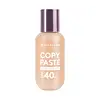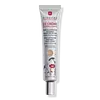What's inside
What's inside
 Key Ingredients
Key Ingredients

 Benefits
Benefits

 Concerns
Concerns

 Ingredients Side-by-side
Ingredients Side-by-side

Water
Skin ConditioningCyclopentasiloxane
EmollientTitanium Dioxide
Cosmetic ColorantEthylhexyl Methoxycinnamate
UV AbsorberCyclohexasiloxane
EmollientGlycerin
HumectantPhenyl Trimethicone
Skin ConditioningCetyl Ethylhexanoate
EmollientCetyl PEG/PPG-10/1 Dimethicone
EmulsifyingPropylene Glycol Dibenzoate
Skin ConditioningEthylhexyl Salicylate
UV AbsorberMethyl Methacrylate Crosspolymer
Pentylene Glycol
Skin ConditioningDimethicone
EmollientPEG-10 Dimethicone
Skin ConditioningZinc Oxide
Cosmetic ColorantMagnesium Sulfate
Phenoxyethanol
PreservativeSilica
AbrasiveTrimethylsiloxysilicate
EmollientDimethicone/Vinyl Dimethicone Crosspolymer
Skin ConditioningAluminum Hydroxide
EmollientBetaine
HumectantDisteardimonium Hectorite
StabilisingTriethoxycaprylylsilane
Stearic Acid
CleansingEthylhexylglycerin
Skin ConditioningDisodium EDTA
BHT
AntioxidantAllantoin
Skin ConditioningCaffeine
Skin ConditioningCI 77491
Cosmetic ColorantCI 77499
Cosmetic ColorantHydrolyzed Sodium Hyaluronate
Skin ConditioningCI 77492
Cosmetic Colorant1,2-Hexanediol
Skin ConditioningWater, Cyclopentasiloxane, Titanium Dioxide, Ethylhexyl Methoxycinnamate, Cyclohexasiloxane, Glycerin, Phenyl Trimethicone, Cetyl Ethylhexanoate, Cetyl PEG/PPG-10/1 Dimethicone, Propylene Glycol Dibenzoate, Ethylhexyl Salicylate, Methyl Methacrylate Crosspolymer, Pentylene Glycol, Dimethicone, PEG-10 Dimethicone, Zinc Oxide, Magnesium Sulfate, Phenoxyethanol, Silica, Trimethylsiloxysilicate, Dimethicone/Vinyl Dimethicone Crosspolymer, Aluminum Hydroxide, Betaine, Disteardimonium Hectorite, Triethoxycaprylylsilane, Stearic Acid, Ethylhexylglycerin, Disodium EDTA, BHT, Allantoin, Caffeine, CI 77491, CI 77499, Hydrolyzed Sodium Hyaluronate, CI 77492, 1,2-Hexanediol
Water
Skin ConditioningCyclomethicone
EmollientDipropylene Glycol
HumectantGlycerin
HumectantPEG-10 Dimethicone
Skin ConditioningMethyl Trimethicone
Skin ConditioningC12-15 Alkyl Benzoate
AntimicrobialDimethicone
EmollientDisteardimonium Hectorite
StabilisingMagnesium Sulfate
Vinyl Dimethicone/Methicone Silsesquioxane Crosspolymer
Centella Asiatica Extract
CleansingMel
EmollientTalc
AbrasiveDimethicone/Vinyl Dimethicone Crosspolymer
Skin ConditioningPhenoxyethanol
PreservativeEthylhexylglycerin
Skin ConditioningTrihydroxystearin
Skin ConditioningButylene Glycol
HumectantMica
Cosmetic ColorantAluminum Hydroxide
EmollientPalmitic Acid
EmollientStearic Acid
CleansingPolyester-1
Silica Dimethyl Silylate
EmollientTocopheryl Acetate
AntioxidantMethicone
EmollientTocopherol
AntioxidantParfum
MaskingHexyl Cinnamal
PerfumingAlpha-Isomethyl Ionone
PerfumingLinalool
PerfumingCitronellol
PerfumingGeraniol
PerfumingEugenol
PerfumingLimonene
PerfumingCI 77492
Cosmetic ColorantCI 77491
Cosmetic ColorantCI 77499
Cosmetic ColorantWater, Cyclomethicone, Dipropylene Glycol, Glycerin, PEG-10 Dimethicone, Methyl Trimethicone, C12-15 Alkyl Benzoate, Dimethicone, Disteardimonium Hectorite, Magnesium Sulfate, Vinyl Dimethicone/Methicone Silsesquioxane Crosspolymer, Centella Asiatica Extract, Mel, Talc, Dimethicone/Vinyl Dimethicone Crosspolymer, Phenoxyethanol, Ethylhexylglycerin, Trihydroxystearin, Butylene Glycol, Mica, Aluminum Hydroxide, Palmitic Acid, Stearic Acid, Polyester-1, Silica Dimethyl Silylate, Tocopheryl Acetate, Methicone, Tocopherol, Parfum, Hexyl Cinnamal, Alpha-Isomethyl Ionone, Linalool, Citronellol, Geraniol, Eugenol, Limonene, CI 77492, CI 77491, CI 77499
 Reviews
Reviews

Ingredients Explained
These ingredients are found in both products.
Ingredients higher up in an ingredient list are typically present in a larger amount.
Aluminum Hydroxide is a form of aluminum. It can be naturally found in nature as the mineral gibbsite. In cosmetics, Aluminum Hydroxide is used as a colorant, pH adjuster, and absorbent.
As a colorant, Aluminum Hydroxide may add opacity, or reduce the transparency. Aluminum hydroxide is contains both basic and acidic properties.
According to manufacturers, this ingredient is an emollient and humectant. This means it helps hydrate the skin.
In medicine, this ingredient is used to help relieve heartburn and help heal ulcers.
There is currently no credible scientific evidence linking aluminum hydroxide in cosmetics to increased cancer risk.
Major health organizations allow the use of aluminum hydroxide in personal care products and have not flagged it as a carcinogenic risk at typical usage levels.
Learn more about Aluminum HydroxideCi 77491 is also hydrated iron III oxide. It's sole purpose is to give a red/pink hue to products.
Iron III oxides are classified as inorganic chemicals for coloring.
Synthetically created Ci 77491 is considered safer than those naturally found. This is because the synthetically created version may contain less impurities. Iron oxides are generally non-toxic and non-allergenic.
Learn more about CI 77491Ci 77492 is also hydrated iron III oxide. It's sole purpose is to give a yellow hue to products.
Iron III oxides are classified as inorganic chemicals for coloring.
Synthetically created Ci 77492 is considered safer than those naturally found. This is because the synthetically created version may contain less impurities. Iron oxides are generally non-toxic and non-allergenic.
Learn more about CI 77492Ci 77499 is also hydrated iron III oxide. It is created from mixing red and black iron oxides. This helps give shades of darkness to a product.
Iron III oxides are classified as inorganic chemicals for coloring.
Dimethicone is a type of synthetic silicone created from natural materials such as quartz.
What it does:
Dimethicone comes in different viscosities:
Depending on the viscosity, dimethicone has different properties.
Ingredients lists don't always show which type is used, so we recommend reaching out to the brand if you have questions about the viscosity.
This ingredient is unlikely to cause irritation because it does not get absorbed into skin. However, people with silicone allergies should be careful about using this ingredient.
Note: Dimethicone may contribute to pilling. This is because it is not oil or water soluble, so pilling may occur when layered with products. When mixed with heavy oils in a formula, the outcome is also quite greasy.
Learn more about DimethiconeThis ingredient is a silicone used to improve the texture of products and absorb oil. It does not get absorbed into the skin.
Like other silicones, Dimethicone/Vinyl Dimethicone Crosspolymer helps condition the skin by creating a barrier. In this sense, it can act as an emollient and trap moisture in.
This ingredient is a type of elastomer.
Learn more about Dimethicone/Vinyl Dimethicone CrosspolymerDisteardimonium Hectorite comes from the clay mineral named hectorite. It is used to add thickness to a product.
It can also help stabilize a product by helping to disperse other ingredients.
Hectorite is a rare, white clay mineral.
Learn more about Disteardimonium HectoriteEthylhexylglycerin (we can't pronounce this either) is commonly used as a preservative and skin softener. It is derived from glyceryl.
You might see Ethylhexylglycerin often paired with other preservatives such as phenoxyethanol. Ethylhexylglycerin has been found to increase the effectiveness of these other preservatives.
Glycerin is already naturally found in your skin. It helps moisturize and protect your skin.
A study from 2016 found glycerin to be more effective as a humectant than AHAs and hyaluronic acid.
As a humectant, it helps the skin stay hydrated by pulling moisture to your skin. The low molecular weight of glycerin allows it to pull moisture into the deeper layers of your skin.
Hydrated skin improves your skin barrier; Your skin barrier helps protect against irritants and bacteria.
Glycerin has also been found to have antimicrobial and antiviral properties. Due to these properties, glycerin is often used in wound and burn treatments.
In cosmetics, glycerin is usually derived from plants such as soybean or palm. However, it can also be sourced from animals, such as tallow or animal fat.
This ingredient is organic, colorless, odorless, and non-toxic.
Glycerin is the name for this ingredient in American English. British English uses Glycerol/Glycerine.
Learn more about GlycerinMagnesium Sulfate is a salt. More specifically, it is an epsom salt, or the bath salt used to help relieve muscle aches.
Despite having ‘sulfate’ in the name, it isn’t a surfactant or cleansing agent like sodium lauryl sulfate. Unlike those sulfates, magnesium sulfate doesn’t have the same cleansing or foaming properties (it's simply a type of salt).
In cosmetics, Magnesium Sulfate is used to thicken a product or help dilute other solids. It is a non-reactive and non-irritating ingredient.
One study shows magnesium deficiency may lead to inflammation of the skin. Applying magnesium topically may help reduce inflammation.
You can find this ingredient in sea water or mineral deposits.
Learn more about Magnesium SulfatePeg-10 Dimethicone is silicone with conditioner and emulsifier properties. It mostly acts as an emollient in skincare and and humectant in haircare.
According to the manufacturer, acidic formulations decrease the stability of this ingredient. It works best in neutral or near neutral formulations.
Phenoxyethanol is a preservative that has germicide, antimicrobial, and aromatic properties. Studies show that phenoxyethanol can prevent microbial growth. By itself, it has a scent that is similar to that of a rose.
It's often used in formulations along with Caprylyl Glycol to preserve the shelf life of products.
Stearic Acid is a fatty acid. It is an emollient, emulsifier, and texture enhancer.
As an emollient, stearic acid helps soften skin. It aids the skin's protective barrier by preventing water loss. It also provides a gentle cleansing effect without stripping away natural oils.
Stearic acid may also be used to enhance the texture of products. It can add volume and stabilize ingredients such as water and oil. This can help water and oil ingredients from separating.
Sources of stearic acid include animal or vegetable fats/oils such as coconut or shea. It can be naturally found in butter, cocoa butter, shea butter, vegetable fats, and animal tallow.
This ingredient may not be Malassezia folliculitis, or fungal-acne safe.
Learn more about Stearic AcidWater. It's the most common cosmetic ingredient of all. You'll usually see it at the top of ingredient lists, meaning that it makes up the largest part of the product.
So why is it so popular? Water most often acts as a solvent - this means that it helps dissolve other ingredients into the formulation.
You'll also recognize water as that liquid we all need to stay alive. If you see this, drink a glass of water. Stay hydrated!
Learn more about Water